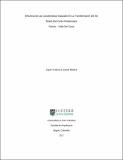Mostrar el registro sencillo del Documento
Influencia de las características espaciales en la transformación del ser diseño del centro penitenciario Palmira - Valle del Cauca
| dc.contributor.advisor | Sarmiento Valdés, Fabián Alonso | spa |
| dc.contributor.author | Laverde Medina, Ingrid Yulanny | spa |
| dc.date.accessioned | 2019-06-07T12:55:32Z | |
| dc.date.available | 2019-06-07T12:55:32Z | |
| dc.date.issued | 2017 | spa |
| dc.identifier.uri | http://hdl.handle.net/11396/3682 | |
| dc.description | La presente tesis se compone de un estudio inicial sobre la situación actual de las penitenciarías en Colombia, de cómo la crisis que se ha desarrollado a través de los años a afectando severamente la población reclusa, en donde los espacios denigran completamente al ser humano afectando su dimensión física, psicológica y espiritual. Aunque los centros penitenciarios que se han construido desde el 2010 definido como ERON (Establecimientos De Reclusión de Orden Nacional) han tratado de mitigar problemáticas como hacinamiento, mala infraestructura, seguridad, servicios en la salud física y mental, habitabilidad, resocialización y aplicación de tecnologías aún no ha sido suficiente para lograr que el individuo se integre con la sociedad. Es por esto que el propósito de este proyecto es diseñar una propuesta arquitectónica en el Municipio de Palmira - Valle del Cauca que impacte de forma positiva e influya en el ser a partir de sus tres dimensiones, en el cual a través de elementos característicos como los son la relación con la naturaleza, la percepción del espacio, colores, texturas, significado del lugar, elaboración de escenarios diferentes, la comunión e integración con la familia y el exterior se logre la resocialización, además de contar con los programas básicos actuales que poseen las cárceles. La idea es cambiar totalmente el concepto de cárcel identificado como el típico lugar creado para encerrar y castigar si no transformar para que se convierta en un complejo autosustentable generador de oportunidades y que reforme al individuo para entregar una persona diferente a la sociedad. Este proyecto está diseñado para albergar 3.000 personas con diferentes perfiles y conductas delictivas en donde allí tendrán la oportunidad de aprender, trabajar, reparar víctimas, habitar y convivir en armonía durante su estadía, el objetivo es mantener a la persona lo más ocupada posible durante el día con diferentes actividades para que se auto sustente y valla desarrollando destrezas que le permitan tener una visión distinta a la de delinquir, para esto el aspecto arquitectónico es muy importante porque es el espacio el que permite fomentar estos programas, y es la característica de este lugar el que ayuda a percibir el sitio como un elemento para el cambio. | spa |
| dc.description.abstract | This thesis is composed of an initial study on the current situation of penitentiaries in Colombia, how the crisis that has developed over the years to severely affecting the prison population, where spaces completely denigrate the human being affecting Its physical, psychological and spiritual dimension. Although penitentiary centers that have been built since 2010 defined as ERON (National Order Detention Establishments) have tried to mitigate problems such as overcrowding, poor infrastructure, security, services in physical and mental health, habitability, re-socialization and application of technologies Has not yet been enough to make the individual integrate with society. That is why the purpose of this project is to design an architectural proposal in the municipality of Palmira - Valle del Cauca that impacts positively and influences being from its three dimensions, in which through characteristic elements such as Are the relationship with nature, the perception of space, colors, textures, meaning of the place, elaboration of different scenarios, communion and integration with the family and the exterior is achieved the re-socialization, in addition to having the current basic programs that have The prisons. The idea is to totally change the concept of jail identified as the typical place created to lock and punish if not transformed so that it becomes a self-sustaining generator of opportunities and reform the individual to deliver a different person to society. This project is designed to house 3,000 people with different profiles and criminal behavior where they will have the opportunity to learn, work, repair victims, live and live in harmony during their stay, the objective is to keep the person as busy as possible during the Day with different activities so that it supports itself and fences developing skills that allow it to have a different vision to that of crime, for this the architectural aspect is very important because it is the space that allows to foment these programs, and is the characteristic of this Place that helps to perceive the site as an element for change. | spa |
| dc.language.iso | spa | spa |
| dc.publisher | Universidad La Gran Colombia | spa |
| dc.subject | Habitabilidad | spa |
| dc.subject | Resocialización | spa |
| dc.title | Influencia de las características espaciales en la transformación del ser diseño del centro penitenciario Palmira - Valle del Cauca | spa |
| dc.subject.lemb | Confinamiento | spa |
| dc.subject.lemb | Prisiones - Espacio personal | spa |
| dc.subject.lemb | Prisiones - Diseño estructural | spa |
| dc.publisher.department | Arquitectura | spa |
| dc.publisher.program | Arquitectura | spa |
| dc.coverage.sede | Bogotá | spa |
| dc.creator.degree | Arquitecto(a) | spa |
Ficheros en el Documento
Este Documento aparece en la(s) siguiente(s) colección(ones)
-
Arquitectura [1096]








